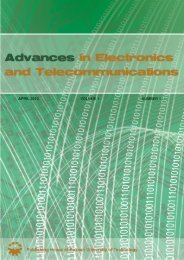november 2010 volume 1 number 2 - Advances in Electronics and ...
november 2010 volume 1 number 2 - Advances in Electronics and ...
november 2010 volume 1 number 2 - Advances in Electronics and ...
Create successful ePaper yourself
Turn your PDF publications into a flip-book with our unique Google optimized e-Paper software.
24 ADVANCES IN ELECTRONICS AND TELECOMMUNICATIONS, VOL. 1, NO. 2, NOVEMBER <strong>2010</strong><br />
(a)<br />
(b)<br />
Fig. 2. History of error e k versus iterations for: (a) traditional antennas, (b)<br />
SA.<br />
The dashed horizontal l<strong>in</strong>es <strong>in</strong> Fig. 2 mark the error level<br />
of 10 −6 at which the iterative process is stopped. It follows<br />
from Fig. 2(a) that this level or lower is reached by the CGS,<br />
CGLS, BiCG, BiCGSTAB, QMR <strong>and</strong> GMRES after runn<strong>in</strong>g<br />
7, 10, 9, 6, 9 <strong>and</strong> 9 iterations, respectively. For SAs (see<br />
Fig. 2(b)), this level is reached with<strong>in</strong> 3, 5, 5, 3, 5 <strong>and</strong><br />
5 iterations for respective methods. In [6] the Richardson,<br />
Jacobi, Gauss-Seidel, SOR methods stopped at the same error<br />
level after perform<strong>in</strong>g 36, 50, 29, 14 iterations for traditional<br />
antennas, <strong>and</strong> 15, 4, 3, 5 iterations for SAs, respectively. All<br />
the discussed methodshavebeenappliedto the preconditioned<br />
versionofthesystem(1),wheretheright-h<strong>and</strong>precondition<strong>in</strong>g<br />
was applied as <strong>in</strong> [1], [6], [7].<br />
To simplifythecomparisonanalysis,letusdropthenotation<br />
of the k<strong>in</strong>d of arithmetic operations. First, let us consider<br />
traditional antennas. Thus, it follows from Table I that the<br />
computational cost of perform<strong>in</strong>g 7 iterations with the CGS is<br />
about 28K 2 + 154K arithmetic operations. For the CGLS,<br />
BiCG, BiCGSTAB <strong>and</strong> QMR we have: 100K 2 + 130K,<br />
91K 2 +171K, 72K 2 +156K <strong>and</strong> 54K 2 +252K+18K,respectively,<br />
where additional 18K <strong>in</strong> QMR means the cost related<br />
to the function evaluation, which may be quite expensive but<br />
dependent on the software <strong>and</strong> hardware used. To rem<strong>in</strong>d, we<br />
got 72K 2 + 108K, 100K 2 + 150K, 87K 2 , <strong>and</strong> 44K 2 + 16K<br />
for the preconditionedRichardson,Jacobi’s, Gauss-Seidel,<strong>and</strong><br />
SOR methods. A similar analysis for the case of SAs gives<br />
the follow<strong>in</strong>g rough estimations of the costs: 32K 2 + 46K,<br />
8K 2 + 12K, 9K 2 , 16K 2 + 6K, 14K 2 + 67K, 50K 2 + 65K,<br />
45K 2 + 95K, 36K 2 + 78K, <strong>and</strong> 30K 2 + (140 + 10)K for<br />
the correspond<strong>in</strong>gmethods: Richardson, Jacobi, Gauss-Seidel,<br />
SOR, CGS, CGLS, BiCG, BiCGSTAB, <strong>and</strong> QMR. Because<br />
the estimation of the cost for GMRES is not so easy, we<br />
compare this method only with respect to the elapsed time<br />
of perform<strong>in</strong>g 10 iterations <strong>in</strong> the same computational <strong>and</strong><br />
hardware environment (MATLAB 7.0).<br />
The elapsed time [<strong>in</strong> seconds] measured <strong>in</strong> MATLAB is<br />
given<strong>in</strong> TableIIwherewe comparethe methodsappliedto the<br />
problemsof different scales. The first two columnsrefer to the<br />
small-scale problem that occured after apply<strong>in</strong>g the dimension<br />
reduction technique ( [2], [3]) to the snapshot described above<br />
(M = 104, K = 1000). Thus, our system matrix is reduced<br />
to the size 104 by 104. S<strong>in</strong>ce <strong>in</strong> real applications much bigger<br />
problems must be resolved, we analyze a bigger case – the<br />
snapshot with 300 cells <strong>and</strong> 3000 users – without us<strong>in</strong>g the<br />
dimension reduction technique but with the above-mentioned<br />
precondition<strong>in</strong>g. The elapsed times are given <strong>in</strong> the last two<br />
columns.Notethatthemeasuredtimeisexemplary<strong>and</strong><strong>in</strong>each<br />
snapshot it may be slightly different due to the difference <strong>in</strong><br />
properties of the system matrix.<br />
IV. CONCLUSIONS<br />
Compar<strong>in</strong>g the estimations of the computational costs, we<br />
canconcludethattheGauss-Seidelmethodisthe mostpromis<strong>in</strong>g,<br />
especially for the SA case. For the traditional antennas,<br />
the CGS is the fastest, <strong>and</strong> then the SOR.<br />
However, with reference to Table II, we can conclude that<br />
for large-scale problems the GMRES is the fastest algorithm.<br />
Thus, for the analysis of a large network (with many BSs), the<br />
GMRES should be used <strong>in</strong> a static simulator. For small-scale<br />
problems, especially for a small <strong>number</strong> of BSs, the Gauss-<br />
Seidel <strong>and</strong> CGS are optimal.<br />
ACKNOWLEDGMENTS<br />
This work was supported with the Grant No. N517 010<br />
32/1675 from Polish State Committee for Scientific Research.<br />
REFERENCES<br />
[1] M. J. Nawrocki, M. Dohler, <strong>and</strong> A. H. Aghvami, Eds., Underst<strong>and</strong><strong>in</strong>g<br />
UMTS Radio Network Modell<strong>in</strong>g, Plann<strong>in</strong>g <strong>and</strong> Automated Optimisation:<br />
Theory <strong>and</strong> Practice. John Wiley <strong>and</strong> Sons, 2006.<br />
[2] L. Mendo <strong>and</strong> J. M. Hern<strong>and</strong>o, “On dimension reduction for the power<br />
control,” IEEE Trans. On Communications, vol. 49, no. 2, pp. 243–248,<br />
2001.<br />
[3] R. Zdunek <strong>and</strong> M. J. Nawrocki, “Improved model<strong>in</strong>g of highly loaded<br />
UMTS network with nonnegative constra<strong>in</strong>ts,” <strong>in</strong> IEEE 17th International<br />
Symposium on Personal, Indoor <strong>and</strong> Mobile Radio Communications<br />
(PIMRC 2006), Hels<strong>in</strong>ki, F<strong>in</strong>l<strong>and</strong>, September 2006.<br />
[4] J. Laiho, A. Wacker, <strong>and</strong> T. Novosad, Radio Network Plann<strong>in</strong>g <strong>and</strong><br />
Optimization for UMTS. Chichester: John Wiley <strong>and</strong> Sons, 2002.<br />
[5] A.Wacker, J.Laiho-Steffens, K.Sipila, <strong>and</strong> M.Jasberg,“Static simulator<br />
for study<strong>in</strong>g WCDMA radio network plann<strong>in</strong>g issues,” <strong>in</strong> Proc. IEEE<br />
Vehicular Technology Conference, Houston, Texas, USA, May 1999, pp.<br />
2436–2440.







